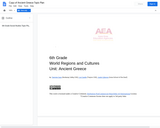
24-28 day unit on Ancient Greece geared toward 6th grade.
- Subject:
- Social Science
- Material Type:
- Unit of Study
- Author:
- Justin Cyboron
- Lori Castle
- Tammie Cass
- Date Added:
- 05/28/2019

24-28 day unit on Ancient Greece geared toward 6th grade.
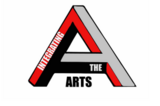
This resource was created by Cierra Morten, in collaboration with Dawn DeTurk, Hannah Blomstedt, and Julie Albrecht, as part of ESU2's Integrating the Arts project. This project is a four year initiative focused on integrating arts into the core curriculum through teacher education, practice, and coaching.

In this elementary textbook, Philip S. Peek draws on his twenty-five years of teaching experience to present the ancient Greek language in an imaginative and accessible way that promotes creativity, deep learning, and diversity. The course is built on three pillars: memory, analysis, and logic. Readers memorize the top 250 most frequently occurring ancient Greek words, the essential word endings, the eight parts of speech, and the grammatical concepts they will most frequently encounter when reading authentic ancient texts. Analysis and logic exercises enable the translation and parsing of genuine ancient Greek sentences, with compelling reading selections in English and in Greek offering starting points for contemplation, debate, and reflection. A series of embedded Learning Tips help teachers and students to think in practical and imaginative ways about how they learn. This combination of memory-based learning and concept- and skill-based learning gradually builds the confidence of the reader, teaching them how to learn by guiding them from a familiarity with the basics to proficiency in reading this beautiful language. Ancient Greek I: A 21st-Century Approach is written for high-school and university students, but is an instructive and rewarding text for anyone who wishes to learn ancient Greek.

This course explores the relationship between ancient Greek philosophy and mathematics. We investigate how ideas of definition, reason, argument and proof, rationality / irrationality, number, quality and quantity, truth, and even the idea of an idea were shaped by the interplay of philosophic and mathematical inquiry. The course examines how discovery of the incommensurability of magnitudes challenged the Greek presumption that the cosmos is fully understandable. Students explore the influence of mathematics on ancient Greek ethical theories. We read such authors as: Euclid, Plato, Aristotle, Nicomachus, Theon of Smyrna, Bacon, Descartes, Dedekind, and Newton.
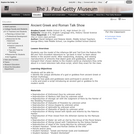
Students use the model of the infamous Bill and Ted from the feature film "Bill and Ted's Excellent Adventure" to "go back in time" to learn about deities in the ancient world. After researching, studying, and viewing reproductions of artworks that depict gods and goddesses, students transport their chosen deities to the modern world as characters they write about in a mock television talk-show script, which they enact for the class.
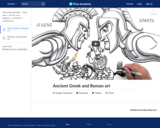
From the Utah System of Higher Education (with special thanks to Dr. Nancy Ross). Video by Ydraw. Created by Nancy Ross.

Essential Morphology and Syntax for Beginning Greek
Word Count: 68061
(Note: This resource's metadata has been created automatically as part of a bulk import process by reformatting and/or combining the information that the author initially provided. As a result, there may be errors in formatting.)

Essential Morphology and Syntax for Beginning Greek
Word Count: 70368
(Note: This resource's metadata has been created automatically as part of a bulk import process by reformatting and/or combining the information that the author initially provided. As a result, there may be errors in formatting.)
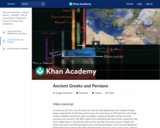
Sal provides an overview of the Greco-Persian Wars and the Peloponnesian War.
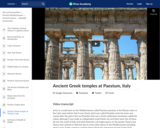
Ancient Greek Temples at Paestum: Hera I, c. 560-530 B.C.E., Archaic Period; Hera II, c. 460 B.C.E., Classical Period; Temple of Minerva, c. 500 B.C.E. Archaic Period. A conversation with Dr. Beth Harris and Dr. Steven Zucker. Created by Beth Harris and Steven Zucker.
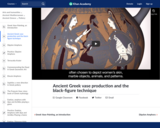
Used for the storage and shipment of grains, wine, and other goods, as well as in the all-male Greek drinking party, known as the symposium, ancient Greek vases were decorated with a variety of subjects ranging from scenes of everyday life to the tales of heroes and gods. The two most popular techniques of vase decoration were the black-figure technique, so-named because the figures were painted black, and the red-figure technique, in which the figures were left the red color of the clay. The black-figure technique developed around 700 B.C. and remained the most popular Greek pottery style until about 530 B.C., when the red-figure technique was developed, eventually surpassing it in popularity. This video illustrates the techniques used in the making and decorating of a black-figure amphora (storage jar) in the Art Institute of Chicago's collection. This video was produced with the generous support of a Long Range Fund grant provided by the Community Associates of the Art Institute of Chicago. It was created for LaunchPad, a program of digital interpretive materials that supplement the viewing of works of art on display in the Art Institute of Chicago's galleries. Created by Getty Museum.
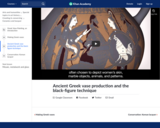
Used for the storage and shipment of grains, wine, and other goods, as well as in the all-male Greek drinking party, known as the symposium, ancient Greek vases were decorated with a variety of subjects ranging from scenes of everyday life to the tales of heroes and gods. The two most popular techniques of vase decoration were the black-figure technique, so-named because the figures were painted black, and the red-figure technique, in which the figures were left the red color of the clay. The black-figure technique developed around 700 B.C. and remained the most popular Greek pottery style until about 530 B.C., when the red-figure technique was developed, eventually surpassing it in popularity. This video illustrates the techniques used in the making and decorating of a black-figure amphora (storage jar) in the Art Institute of Chicago's collection. This video was produced with the generous support of a Long Range Fund grant provided by the Community Associates of the Art Institute of Chicago. It was created for LaunchPad, a program of digital interpretive materials that supplement the viewing of works of art on display in the Art Institute of Chicago's galleries. Created by Getty Museum.

This short video describes how the compression of Antarctic snow into ice captures air from past atmospheres. It shows how ice cores are drilled from the Antarctic ice and prepared for shipment and subsequent analysis.
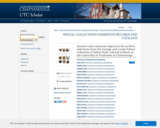
Early in the Spring 2020 semester, University of Tennessee at Chattanooga students in my Ancient to Modern Latin American Visual Culture Art History course embarked upon an intensive first-hand visual analysis and research project that involved working directly with original artifacts from Ancient Latin America housed within the University of Tennessee at Chattanooga Library’s Special Collections. This unique opportunity and the publication of their findings were made possible thanks to the generous support and assistance of Special Collections Director Carolyn Runyon and her dedicated staff.
By examining the wide array of Pre-Columbian objects in the George and Louise Patten Salem Hyde Papers and Cultural Artifacts Collection, these upper division students formed small research groups dedicated to specific artifact types, such as human figurines, animal figurines, tools and lithics, vessels, anthropomorphic ceramics, replicas, and sherds. They carefully recorded their original observations of their selected objects of study in written field notes, photographs, and drawings. Later, they compared their initial observations with preliminary collection data developed independently by Archaeology students of Dr. Andrew Workinger, leading to further questions and insights surrounding these extraordinary pieces predominantly from pre-contact indigenous cultures of the Central and Intermediate regions of Latin America that today comprise Costa Rica, Ecuador, Panama and Colombia. Building upon their analysis, the Art History student research groups then re-examined their selected artifacts through analytical frameworks focused on Gender and the Body, Color, Pattern and Materiality, Spirituality and the Object, Form and Function, and Identity and Representation. In presenting their findings to their peers, students received feedback that allowed them to refine their analysis and develop the original individual and group catalog essays that comprise this exhibition publication. Their research sheds further light on the extraordinary value and diversity of the ancient artifacts of Latin America that uniquely form part of UTC’s Special Collections, as well as the innovative power of interdisciplinary research and collaboration.
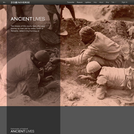
For classics scholars, the vast number of damaged and fragmentary texts from the waste dumps of Greco-Roman Egypt has resulted in a difficult and time-consuming endeavor, with each manuscript requiring a character-by-character transcription. Words are gradually identified based on the transcribed characters and the manuscripts' linguistic characteristics. Both the discovery of new literary texts and the identification of known ones are then based on this analysis in relation to the established canon of extant Greek literature and its lexicons. Documentary texts, letters, receipts, and private accounts, are similarly assessed and identified through key terms and names. Furthermore, an immense number of detached fragments still linger, waiting to be joined with others to form a once intact text of ancient thought, both known and unknown. The data not only continues to reevaluate and assess the literature and knowledge of ancient Greece, but also illuminates the lives and culture of the multi-ethnic society of Greco-Roman Egypt.
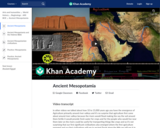
Why is Mesopotamia considered the "cradle of civilization"? Sal explains the history of the early empires on the Tigris and Euphrates rivers.

High level overview from Ancient Egypt to Babylon with reference to stories from the Old Testament.

These educational videos provide an invaluable resource on Ancient Nubia for Middle and High School Ancient World History and Geography teachers and students. The video content aligns with Geography, Economics, Civics, and Historical Thinking Social Studies standards across the nation. Key concepts and inquiry skills from each content area weave seamlessly throughout the videos and associated lesson plans. This unit overview document links to developed resources on the Archeology in the Community site.
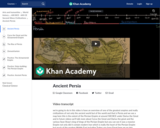
This overview of Ancient Persia explains the origins of the term "Persia" and Zoroastrianism; it also puts the Median, Achaemenid, Seleucid, Parthian, Sassanian dynasties in context.

This course will acquaint the student with some of the ancient Greek contributions to the Western philosophical and scientific tradition. We will examine a broad range of central philosophical themes concerning: nature, law, justice, knowledge, virtue, happiness, and death. There will be a strong emphasis on analyses of arguments found in the texts.